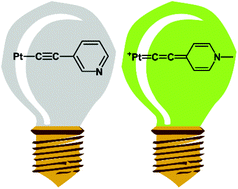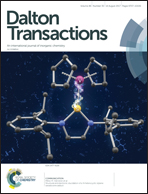Increasing phosphorescent quantum yields and lifetimes of platinum-alkynyl complexes with extended conjugation†
Abstract
The emission of platinum-alkynyl complexes with terminal pyridyl moieties changes upon simple alkylation reactions. Due to growing interest in photovoltaics, photocatalysis, and light-emitting devices, understanding the nature of these changes is important to develop simple synthetic pathways for the rational design of photophysically active molecules. Herein, the choice of ligand isomer, methylation, and Pt-coordination environment on phosphorescent quantum yields, lifetimes, and associated radiative and non-radiative rate constants of eight organometallic complexes were studied. Single-crystal X-ray diffraction experiments and computational studies provide evidence for stabilization of metallo-cumulene resonance forms whose increased rigidities manifest in the observed photophysical changes. This effect is more pronounced for 4-ethynylpyridyl complexes over 3-ethynylpyridyl variants since the metallo-cumulene form shifts electron density to the electronegative N-atom at the para site. Furthermore, the use of σ-donating N-heterocyclic carbenes to complete the Pt-coordination environment enhanced the quantum yield of phosphorescence as high as 39% (λmax = 512 nm) with a lifetime of 21.2 μs.



 Please wait while we load your content...
Please wait while we load your content...